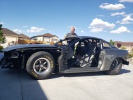I believe that advancing the timing would cause your valve to open sooner (and close sooner) than normal and retarding it opens it later (closes later). Not really sure why there would be overlap once the turbo is spinning. I would have thought that for FI you'd want the intake valve closing as soon as the cylinder was at the bottom. as your suspecting i too think that overlap would just let the forced air right back out of the cylinder when under FI. Im following slightly different rules being NA so i may be wrong about the intake timing but im pretty sure FI you wouldnt want overlap.
Like on the first post saying, you can open the exhaust valve a little before the cylinder reaches the bottom without losing any appreciable power from the stroke and get you hotter exhaust gas pushing through the turbo. That'll get your exhaust valve closing sooner so it should make it easier to avoid overlap with the intake cam
Not to sure how the ecu in the lnf or lsj handles cam timings because on the e67 in the le5 i cant use negative numbers for cam actuation values, only from 0 to 25 in degrees where 0 is the most retarded and 25 is most advanced. At least thats what i gathered when i unplugged the solenoid for the cams and scanned the position sensor for where they were at. That and it felt down on power up in the higher range.
I'd give it a shot to see how it changes airflow and coolant temp and IAT but I don't have a turbo charger (yet)
I attached a pdf of the cam specs for the stock cams, though you probably already have a copy.
i think the natural overlap of the cams is like 6 for the lnf, none by 5 for the lsj, 10 for the le5, and 8 for the l61. Please correct me if im wrong as i very well may be




 Reply With Quote
Reply With Quote
